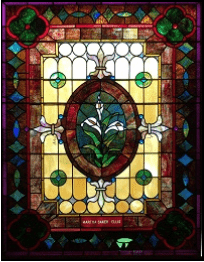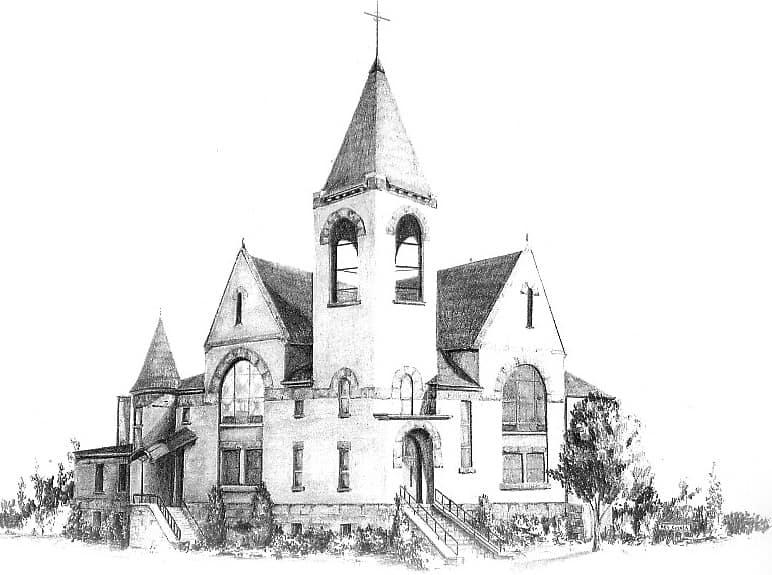The Ellis Windows – Full of Light and Symbolism


When you’re at church, stop and take the time to really look at the beautiful pair of windows on the south wall of the first floor of the sanctuary. They are beautifully illuminated particularly on a sunny day. You’ll first notice that they are very symmetric and geometric, both having quatrefoils at each corner. A quatrefoil is a sohape formed by four overlapping circles of the same diameter, like a four-leaf clover. In Latin the word “quatrefoil” means “four leaves”. And like a four leaf clover, the quatrefoil is an ancient symbol for good luck. In the Christian tradition, the four leaves represent the four evangelists of the Bible: Matthew, Mark, Luke, and John. In Native American culture, the four leaves of the quatrefoil symbolize the four cardinal directions: north, south, east, and west. This symbol has been around for a long time and predates Christianity.
Next, look for the small round- and square-shaped pieces of faceted pieces of blue glass in these windows. These pieces of glass were ground and polished after they were formed. They’re designed to refract and reflect the light coming through the windows and create wonderful patterns on the interior of the church. Look next for the fleurs-de-lis on the four sides of the central oval in each window. “Fleur-de-lis” means lily flower in French and is a very common heraldic and flag symbol in France and much of Europe. In the Christian tradition, it can also represent the Holy Trinity, and in the Catholic church symbolizes the purity and chastity of the Virgin Mary.
Now bring your eye to the oval in the center of each window. The oval on the left hand window contains a grape wine with some leaves and dark purple grapes. This of course symbolizes the blood of Christ and the wine taken during communion. The window on the right has a lily flower in the central oval. As I noted earlier, there are all kinds of legends and symbols associated with the lily. According to one legend, after the death and resurrection of Jesus lilies were found growing in the Garden of Gethsemane where Jesus went to pray the night before his crucifixion. The legend says that the lilies emerged where drops of Christ’s blood fell as he prayed. Another tradition suggests that the lily bulb, when buried in the ground, represents the tomb of Christ; from the cold earth new life is released, like Christ rising from the dead. The Easter lily is reborn to live again, and the white trumpet-like flower symbolizes his life after death. This would explain why we place white Easter lilies in church at Easter.
Now take a few minutes and note the beautiful purple glass surrounding the edge of these windows. Look at all the different swirls of color in the glass, and use your fingers to feel the wave-like texture of the glass. This texture is formed by using rollers on the sheets of glass while it is still hot.
The money for these two windows was donated by Dr. Edwin Ellis and his wife, Martha Baker
Ellis. Their names are etched in the two small glass plaques at the base of the windows. Edwin Ellis was born in Maine in 1824 and died here in Ashland in 1904. After attending Bowdoin College, Ellis attended medical school at the University of New York City. After graduating from medical school in 1846, he set up medical practice in Farmington, Maine, where he married Sophia Davis in 1847. Ellis and his first wife Sophia has a daughter in 1848, but she died in 1849. In 1850, he married Martha Baker Ellis, and in 1853 they moved to St. Paul, Minnesota, moving to the then new town of Ashland in 1854. There he purchased 600 acres of land and laid out the town of Bay City; shortly thereafter, it was consolidated with the City of Ashland. In 1857 there was a severe economic downturn throughout the country, and by the 1860s Ashland was pretty much deserted. Dr. Ellis moved out to Odanah, where he ran the Odanah Mission School, and he also practiced medicine in Ontonagon, Michigan. When the economy improved in 1872, he returned to Ashland and was one of the principals in getting the railroads to extend lines to Ashland.
At this point he stopped practicing medicine and became a real estate developer, insurance salesman, and civic leader. He was a founder of the Ashland National Bank and Northland College, served on the school board, and was active in the Masonic Lodge. He also served on the county board and as the county judge for 17 years.
Dr. Ellis had grown up in the Congregational church, but later in life he became a Presbyterian and was one of the founding members of our church. He contributed funds for the building of the church, including these two windows. His second wife, Martha, died in 1896, so she did not live long enough to see the window in place in the church (construction on the church wasn’t finished until 1897).
Our three-year long window restoration project fundraising effort is underway. We anticipate that the actual work will begin some time in April. We’ve received pledges for just over half of the $150,000 we need to complete this project. Thank you for your generosity and commitment to preserve our beautiful windows.
Jim M., Paul V.P., Darrel R.
Stained Glass Window Restoration Committee
